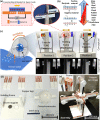Magnetic capsulate triboelectric nanogenerators
- PMID: 34997086
- PMCID: PMC8741797
- DOI: 10.1038/s41598-021-04100-2
Magnetic capsulate triboelectric nanogenerators
Abstract
Triboelectric nanogenerators have received significant research attention in recent years. Structural design plays a critical role in improving the energy harvesting performance of triboelectric nanogenerators. Here, we develop the magnetic capsulate triboelectric nanogenerators (MC-TENG) for energy harvesting under undesirable mechanical excitations. The capsulate TENG are designed to be driven by an oscillation-triggered magnetic force in a holding frame to generate electrical power due to the principle of the freestanding triboelectrification. Experimental and numerical studies are conducted to investigate the electrical performance of MC-TENG under cyclic loading in three energy harvesting modes. The results indicate that the energy harvesting performance of the MC-TENG is significantly affected by the structure of the capsulate TENG. The copper MC-TENG systems are found to be the most effective design that generates the maximum mode of the voltage range is 4 V in the closed-circuit with the resistance of 10 GΩ. The proposed MC-TENG concept provides an effective method to harvest electrical energy from low-frequency and low-amplitude oscillations such as ocean wave.
© 2022. The Author(s).
Conflict of interest statement
The authors declare no competing interests.
Figures





References
-
- Fan FR, Tian ZQ, Wang ZL. Flexible triboelectric generator. Nano Energy. 2012;1(2):328–334. doi: 10.1016/j.nanoen.2012.01.004. - DOI
-
- Askari H, Khajepour A, Khamesee MB, Saadatnia Z, Wang ZL. Piezoelectric and triboelectric nanogenerators: Trends and impacts. Nano Today. 2018;22:10–13. doi: 10.1016/j.nantod.2018.08.001. - DOI
LinkOut - more resources
Full Text Sources

